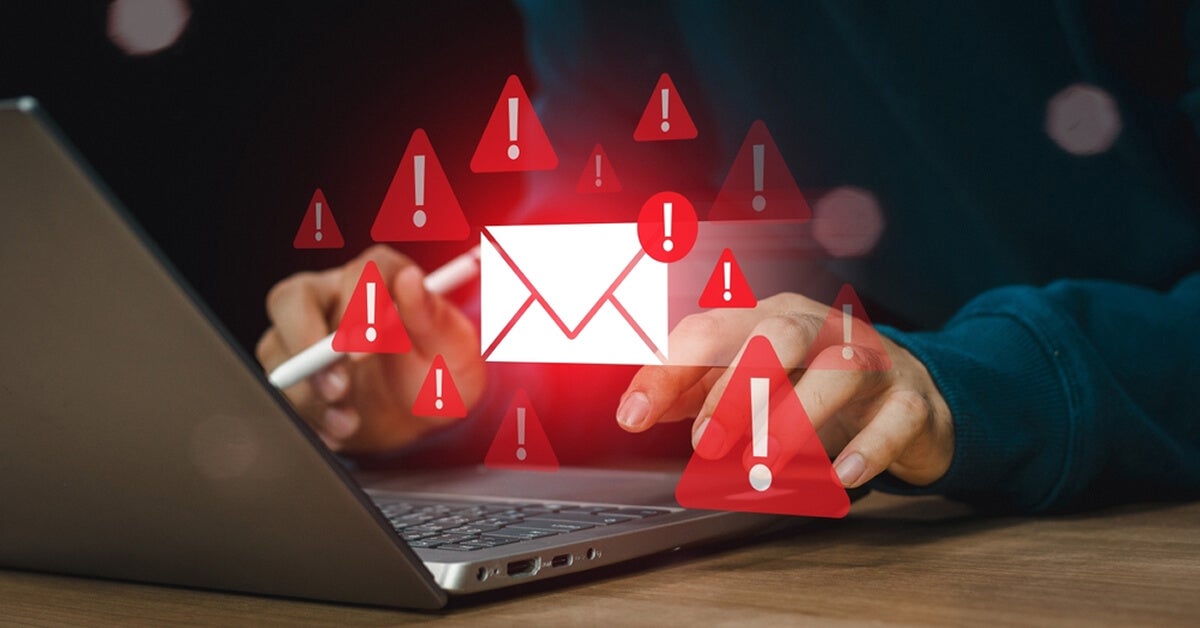Email security focuses on protecting email platforms from threats, such as phishing, malware, and spoofing. It ensures that sensitive conversations stay private, employees are not tricked into sending money, and harmful software does not make its way into systems. As email is one of the most commonly used forms of communication in business, it is a major target for cybercriminals looking to exploit its wide usage to gain access to confidential information, interrupt business processes, or install malicious programs. Effective email cyber security aims to keep emails safe by identifying and stopping these threats before they can do any harm. A secure email system not only safeguards an organization’s data but also helps build trust with clients and partners who depend on secure communication.

Why Email Security Is Important
Email has stayed at the center of digital communication. From casual messages to sensitive business discussions, it is used everywhere — in schools, startups, banks, and government offices. Even with newer chat apps and project platforms, email still handles the bulk of daily communication. According to Statista, an astounding 251.1 million emails were sent in 2024.
Email cyber security matters because attackers rely on how much we trust our inboxes. They send fake notes pretending to be someone you know, attach harmful files that look like invoices, or add links that seem fine at first but quietly steal login details or install unwanted software. These kinds of threats do not always need complex tools. A well-written message is often enough to fool someone into clicking or responding.
Failing to take email security seriously can lead to money theft, personal data being exposure, and major trust issues with clients or customers. A single click on the wrong message could mean a wire transfer lands in a scammer’s account or a spreadsheet full of private info ends up in the wrong hands. In fact, some of the most damaging attacks have come from fake messages that looked like they came from top executives.
Good email cyber security is not just about stopping scammers. It is also about meeting legal standards. Businesses that handle confidential data must protect it. If they do not, they could face heavy fines under laws like GDPR, HIPAA, or other privacy rules. These penalties are not just numbers on paper. They can affect the bottom line, public image, and even long-term survival.
Types of Email Threats
Email threats are constantly shifting. Some are easy to spot, while others are harder to detect and more convincing. Knowing the different ways these threats show up helps people and organizations stay alert and avoid major risks.
Here are a few examples that show why strong protection for email systems is so important.
Phishing
Phishing is one of the most common tricks out there. It involves fake emails that look like they come from someone you know or trust, such as a coworker, your bank, or a service you use. The goal is to get you to click a link or share information like passwords, credit card details, or ID numbers. While some phishing messages are basic, others are crafted to target specific people, using personal info to make them seem believable. These are known as spear phishing attempts. Because they often slip past basic checks, training and smarter filters are key to stopping them.
Malware
Malware also spreads through email. It usually arrives as a file or a link disguised as something harmless, like a PDF or photo. Once clicked or downloaded, it can sneak into your device, take data, or allow someone else to control your system. This can be a serious problem for businesses and individuals alike. Good filters and regular updates can help catch these threats early before they do any damage.
Spam
Spam messages are everywhere. Most of them are just annoying, packed with ads or offers no one asked for. But sometimes spam includes hidden traps such as links that send you to fake sites or files that can harm your device. Even when it’s not dangerous, spam can still slow people down by filling inboxes with junk. Smart filters keep this stuff out so users can focus on what really matters.
Business Email Compromise (BEC)
BEC is another serious issue. In these cases, someone pretends to be a company executive, a vendor, or a manager. They send an urgent request, asking for a money transfer or sensitive data. There is usually no attachment or link, which makes it tricky to catch. The message relies on pressure, trying to make the target act fast without checking. Because of how subtle these attacks can be, it is important to teach staff what to look for and always double-check strange requests, especially those that seem rushed or out of character.
Spoofing
Spoofing occurs when an email appears to be from a familiar sender but is actually from a fake source. The name and address might look real at first glance, but the message comes from a different source entirely, making it easy for someone to fall for it. Email cyber security tools can help verify where emails are really coming from. Adding these tools is one of the most effective ways to stop spoofed messages before they reach your inbox.
Benefits of Email Security
Good email protection does not just stop fraud; it brings a range of perks that help your company stay efficient and avoid unnecessary risks.
Here are a few clear reasons why solid email security is worth the effort.
Safeguards Reputation
Trust takes years to build but can be lost in seconds. If private messages or customer details get exposed through weak email protection, people will think twice before doing business with you. Keeping emails secure shows clients and partners that you take their privacy seriously. That kind of confidence is hard to earn but easy to lose, so prevention is always the better option.
Keeps Focus on What Matters
Sifting through junk emails, scams, and suspicious messages takes up time no one can afford to waste. Good filters keep those distractions away so your team can pay attention to the things that move the needle. No more wasted time trying to figure out if an email is safe or not; instead, people can just focus on doing their jobs.
Meets Legal Obligations
Laws like GDPR exist to ensure the safety of people’s personal information. Ignoring them can lead to serious penalties. A smart email setup helps make sure sensitive data does not fall into the wrong hands. It also gives you peace of mind that your systems are in line with regulators’ expectations.
Cuts Down on Financial Loss
One scam email could mean thousands or even millions lost. From fake invoices to access to accounts, attackers know how to make you pay. Catching those messages early keeps your finances where they belong. Plus, it avoids the headache and costs of cleaning up a mess that could have been stopped.
Builds a Safer Work Environment
If people do not have to second-guess every message, they will be more willing to collaborate and use new tools. Strong email defenses mean fewer worries and fewer mistakes. They also mean faster decisions, smoother teamwork, and a more confident workplace. Everyone wins.
Email Security Best Practices
Following a few proven methods can help lower the chances of email threats disrupting your operations. These steps make it easier to keep your messages secure and your team protected.
1. Use Layers of Protection
Don’t put all your trust in one tool. A mix of filters, scanners, and alert systems works better. Spam filters stop junk from reaching your inbox. Virus scanners catch harmful attachments. Tools that flag strange behavior can warn you early if something’s off. Combining these gives you better coverage and less room for threats to slip through.
2. Keep Everything Updated
Old software gives attackers an easy way in. Updates often fix known problems, so skipping them leaves you exposed. Make it a routine to patch your systems and apps as soon as updates are available. It is one of the simplest ways to close gaps that bad actors look for.
3. Train Your Team
People are often the easiest targets. Even smart staff can fall for a convincing fake email if they have not been trained. Teach your team what to look for — strange links, unfamiliar senders, and odd requests. Run practice drills and refresh training regularly. A well-informed team is less likely to click on something they should not.
4. Add Two-Factor Sign-ins
A password is easy to guess or steal. Adding a second check, like a text message or an app prompt, makes accounts much harder to break into. Even if someone gets a password, they will not be able to log in without that second step. This extra check is a small move that adds real protection.
By putting these steps in place, you make it harder for threats to get through. It is not just about keeping your emails safe; it helps protect your team, your reputation, and your bottom line.
Why Email Security is Essential for an Organization
Email security is a critical aspect of any organization's cybersecurity framework. As threats continue to evolve in complexity and frequency, proactive measures are essential to safeguard sensitive information and maintain trust. From phishing to malware and business email compromise, the risks are real and potentially devastating. Organizations must implement layered security strategies, educate their workforce, and invest in advanced tools to stay ahead of cybercriminals.
Sangfor's comprehensive email security solutions, in conjunction with its endpoint security offerings, provide a robust defense against these threats, ensuring that communication channels remain secure and reliable. With features such as AI-powered threat detection, real-time monitoring, and scalable deployment, Sangfor empowers organizations to protect their most valuable digital asset - email. By integrating Sangfor's Endpoint Secure, businesses can further strengthen their overall security posture, defending against a broad spectrum of cyber risks. Adopting these best practices and using innovative technologies will help organizations confidently navigate the modern threat landscape.
Frequently Asked Questions (FAQs)
Email security is the practice of keeping email accounts, messages, and attachments safe from unwanted access, scams, and data leaks. This includes using filters, software, login checks, and policies to make it harder for attackers to steal information or trick people into revealing sensitive details. It is about making sure your communication stays private and your data doesn't end up in the wrong hands.
Email plays a key role in daily business and personal exchanges. Because of this, attackers often target it to steal money, data, or private records. A single scam email can cause serious problems, from leaking confidential information to triggering financial losses or even legal trouble. Taking steps to secure email can help prevent these kinds of incidents and reduce risk overall.
Use email filters to catch junk and threats before they hit your inbox. Keep your systems current by installing updates as soon as they are released. Organize short training sessions to keep staff alert and teach them how to spot trick messages. Use logins that require more than just a password, and keep an eye on email traffic for anything unusual. These small steps can make a significant difference in keeping your systems safe.
The most frequent ones include phishing, where fake messages trick people into handing over information; malware, which can be hidden in links or attachments; spam, which clogs inboxes and sometimes hides scams; business email scams that pretend to be from company leaders; and spoofing, where the message looks like it's from someone you trust. Each one works a bit differently, so a range of defenses is needed.
Sangfor offers tools that scan messages, flag unusual behavior, and stop threats before they cause damage. The system looks at message patterns and learns from them, which helps catch problems early. It also gives IT teams effortless ways to manage alerts, set rules, and protect users without needing complicated setups. By using Sangfor's tools, businesses can stay one step ahead of email threats and limit their exposure to risk.





